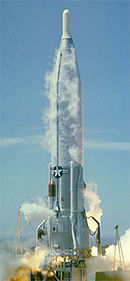Atlas LV-3B
This article includes a list of general references, but it lacks sufficient corresponding inline citations. (March 2011) |
 An Atlas D LV-3B launching Mercury-Atlas 6 | |
| Function | Manned expendable launch system |
|---|---|
| Manufacturer | Convair |
| Country of origin | |
| Size | |
| Height | 28.7 metres (94.3 ft) |
| Diameter | 3.0 metres (10.0 ft) width over boost faring 4.9 metres (16 ft) |
| Mass | 120,000 kilograms (260,000 lb) |
| Stages | 1½ |
| Capacity | |
| Payload to LEO | 1,360 kg[1] |
| Launch history | |
| Status | Retired |
| Launch sites | CCAFS LC-14 |
| Total launches | 9 |
| Success(es) | 7 |
| Failure(s) | 2 |
| First flight | 29 July 1960 |
| Last flight | 15 May 1963 |
| Boosters | |
| No. boosters | 1 |
| Powered by | 2 |
| Maximum thrust | 1,300 kilonewtons (300,000 lbf) |
| Burn time | 134 seconds |
| Propellant | RP-1/LOX |
| First stage | |
| Diameter | 3.0 metres (10.0 ft) |
| Powered by | 1 |
| Maximum thrust | 300 kilonewtons (67,000 lbf) |
| Burn time | 5 minutes |
| Propellant | RP-1/LOX |
The Atlas LV-3B, Atlas D Mercury Launch Vehicle or Mercury-Atlas Launch Vehicle, was a man-rated expendable launch system used as part of the United States Project Mercury to send astronauts into low Earth orbit. It was derived from the SM-65D Atlas missile, and was a member of the Atlas family of rockets.
Nine LV-3Bs were launched, two on unmanned suborbital test flights, three on unmanned orbital test flights, and four with manned Mercury spacecraft.[2][full citation needed] Atlas LV-3B launches were conducted from Launch Complex 14 at Cape Canaveral Air Force Station, Florida.[2]
It first flew on 29 July 1960, conducting the suborbital Mercury-Atlas 1 test flight. The rocket suffered a structural failure shortly after launch, and as a result failed to place the spacecraft onto its intended trajectory.[citation needed] In addition to the maiden flight, the first orbital launch, Mercury-Atlas 3 also failed. This failure was due to a problem with the guidance system failing to execute pitch and roll commands, necessitating that the Range Safety Officer destroy the vehicle. The spacecraft separated by means of its launch escape system and was recovered 1.8 kilometres (1.1 mi) from the launch pad.
A further series of Mercury launches was planned, which would have used additional LV-3Bs; however these flights were canceled after the success of the initial Mercury missions.[citation needed] The last LV-3B launch was conducted on 15 May 1963, for the launch of Mercury-Atlas 9.
See also
References
- ^ Wade, Mark. "Atlas LV-3B / Mercury". Encyclopedia Astronautica. Retrieved 24 November 2011.
- ^ a b Encyclopedia Astronautica - Atlas


